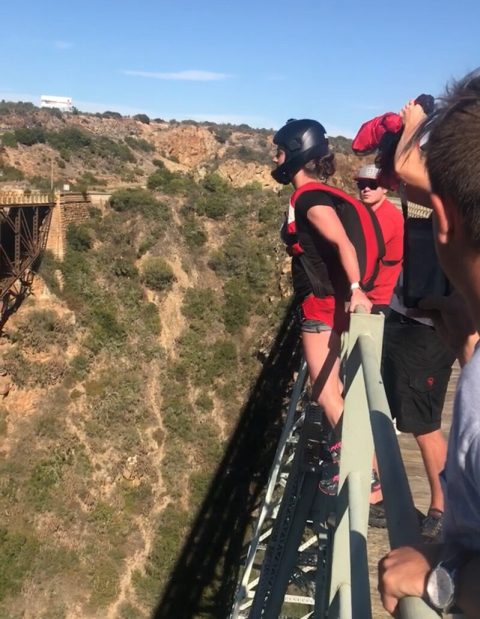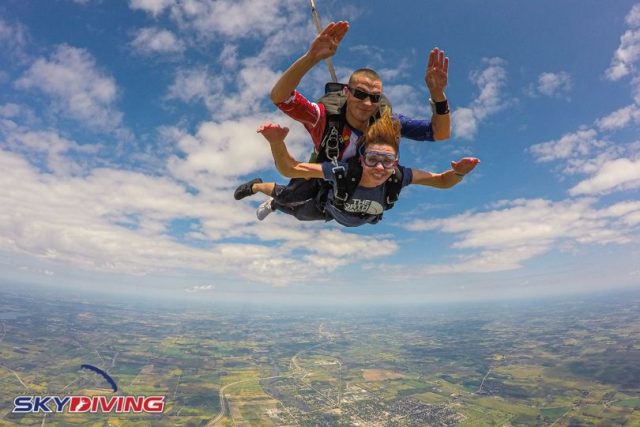What Are The Differences Between Skydiving and BASE Jumping?
General
Posted by: Wisconsin Skydiving Center 1 year ago
It’s easy to see the similarities between skydiving and BASE jumping. You jump, you fly a parachute, and you land, right? Yes, but while BASE jumping and skydiving are evidently related, it may come as a surprise to learn they have very crucial differences that actually separate these two sports into different categories.

WHAT IS BASE JUMPING?
BASE jumping is an extreme sport that has been around for decades. It involves leaping from a stationary object and parachuting to the ground. The word “BASE” is an acronym for Building, Antenna, Span (bridges), Earth (cliffs). These represent the four primary exit points that BASE jumpers will jump from. Free BASE jumping is where the jumpers will free solo, or climb, to the top of tall structures or mountains with their skydiving gear, and jump from the top.
IS BASE JUMPING ILLEGAL?
BASE jumping is prohibited in all National Parks in the US and illegal in certain cities such as Las Vegas and New York City. It is permitted in the Bureau of Land Management and US Forest Service territories. Two popular BASE jumping locations are the Perrine Bridge in Twin Falls, Idaho and the New River Gorge Bridge in Fayetteville, West Virginia.
Although controversial, it’s believed that the main reason why BASE jumping may be illegal in certain areas is because it is considered a potential risk for traffic congestion or pedestrian injury in heavily populated areas, and an unnecessary stressor for National Park visitors and first responders. Penalties for jumping without permission can be severe, so it is essential to check with local authorities before attempting any BASE jumps. Usually, more than anything, it’s the trespassing onto privately owned property that causes issues for certain BASE jumpers.
SKYDIVING VS BASE JUMPING
There are several differences between skydiving and BASE jumping. The biggest differences are the type of equipment used, the exit altitude, and the landing areas.

The Parachute
One key difference between skydiving and BASE jumping is the skydiving equipment. In skydiving, there are two parachutes within the skydiving rig – a main parachute and a “back-up” parachute (reserve) that is carefully packed in a sophisticated and precise skydiving container. The rig often contains a high-tech computer called an Automatic Activation Device (AAD) which will automatically deploy the reserve parachute if the main parachute isn’t manually deployed before certain altitudes and speeds are met. All skydiving gear is regulated under the Federal Aviation Administration (FAA) and the reserve parachute is required to be properly maintained by FAA-certified riggers every 180 days.
In BASE jumping, jumpers use a single-parachute system that is packed within a much simpler “backpack.” BASE parachutes are usually significantly simpler and aren’t really regulated by any organization or government authority. The reason BASE jumpers jump with only one parachute is because there simply isn’t enough time between the jump and the ground to cut away the main parachute and deploy the reserve parachute.
The Exit Altitude
In skydiving, full altitude skydives are typically between 8,000 – 14,000 ft, while low-altitude jumps (“hop n pops”) are performed around 3,500 – 5,000 ft. Whereas, BASE jumps are usually performed from around 300 – 1,000 ft! This number varies based on the height of the object from which the jumper exits.
The Landing Area
Skydiving centers usually a nice open area with plenty of options for a safe landing. They maintain their landing areas by keeping them free from debris to prevent landing injuries. In contrast, BASE jumps are usually made into less than ideal landing areas, such as natural settings, rocky surfaces, streets, other buildings, and power lines are all things BASE jumpers have to be wary of when choosing a BASE jump location.
IS SKYDIVING SAFER THAN BASE JUMPING?
Another supremely important difference is the safety and ultimate risk involved in BASE jumping as compared to skydiving. The margin of survival in BASE jumping is far more narrow than in skydiving.

What is the death rate of BASE jumping?
BASE jumping has a fatality rate of 1 in 2,300 jumps. According to statistics published by the United States Parachute Association, there were 10 fatalities recorded across the 3.57 million jumps that took place in 2021, which is 1 in 357,000 jumps. (Note, tandem skydiving has a much lower fatality rate than that of the licensed skydiver community — there has been an average fatality rate of 1 in 500,000 tandem jumps over the past 10 years.) In short, BASE jumping is a whole lot more dangerous than skydiving. A fact, BASE jumpers readily admit.
IS BASE JUMPING CHEAPER THAN SKYDIVING?
Skydiving costs are cheaper than BASE jumping in the grand scheme of things (not to mention much easier to access) mostly because BASE jumping requires a TON of commitment – time, traveling cost, energy, and mental clarity and focus. The BASE jump training alone can cost around $1,500 not including the additional cost of BASE jumping gear, which can run at about $5,000 for the parachute, container, risers, gear bag, helmet, and body armor.
CAN YOU BASE JUMP WITHOUT SKYDIVING?
Individuals who are interested in BASE jumping are encouraged to start their journey with skydiving first. How many times do you have to skydive before you can BASE jump? Most reputable BASE first jump courses require licensed skydivers to have completed between 200 and 500 jumps before BASE training can begin.
Wherever your jumping journey will take you, start with a tandem skydive at Wisconsin Skydiving Center! Blue skies!
Categories:
You May Be Interested In:

5 Unique Skydiving Proposal Ideas
4 weeks ago by Wisconsin Skydiving Center

The Best Skydiving Memes
2 months ago by Wisconsin Skydiving Center

How Much Do Skydiving Instructors Make?
4 months ago by Wisconsin Skydiving Center

A Day in the Life of a Jumper Pilot
8 months ago by Wisconsin Skydiving Center